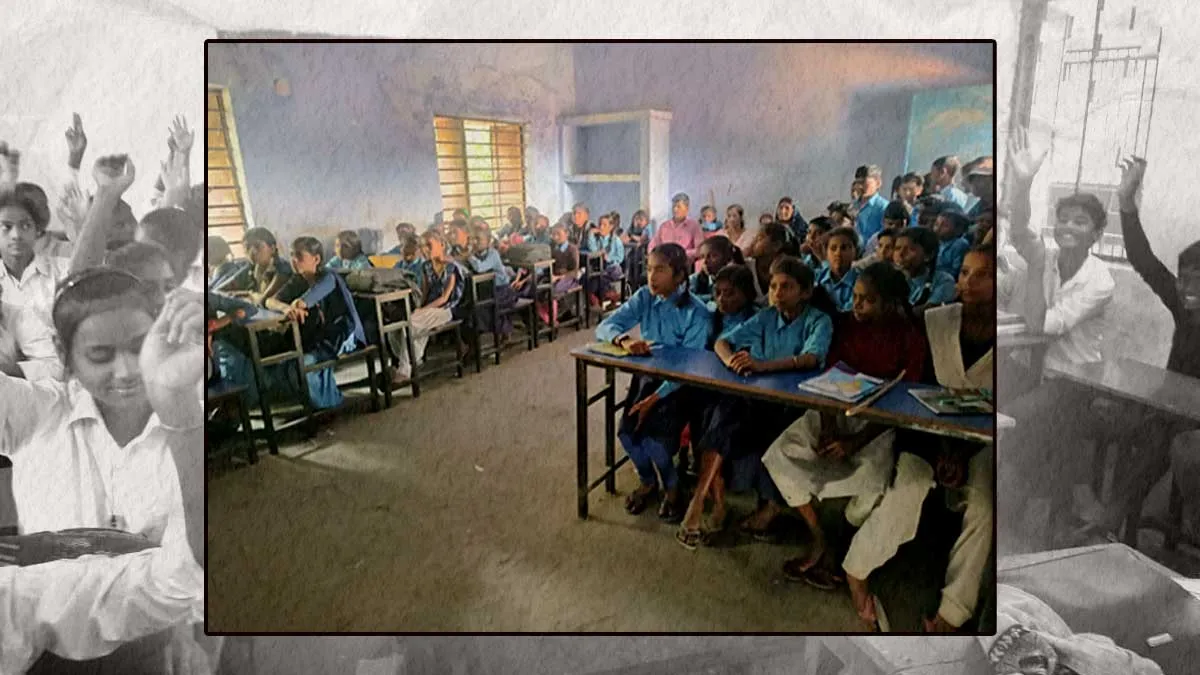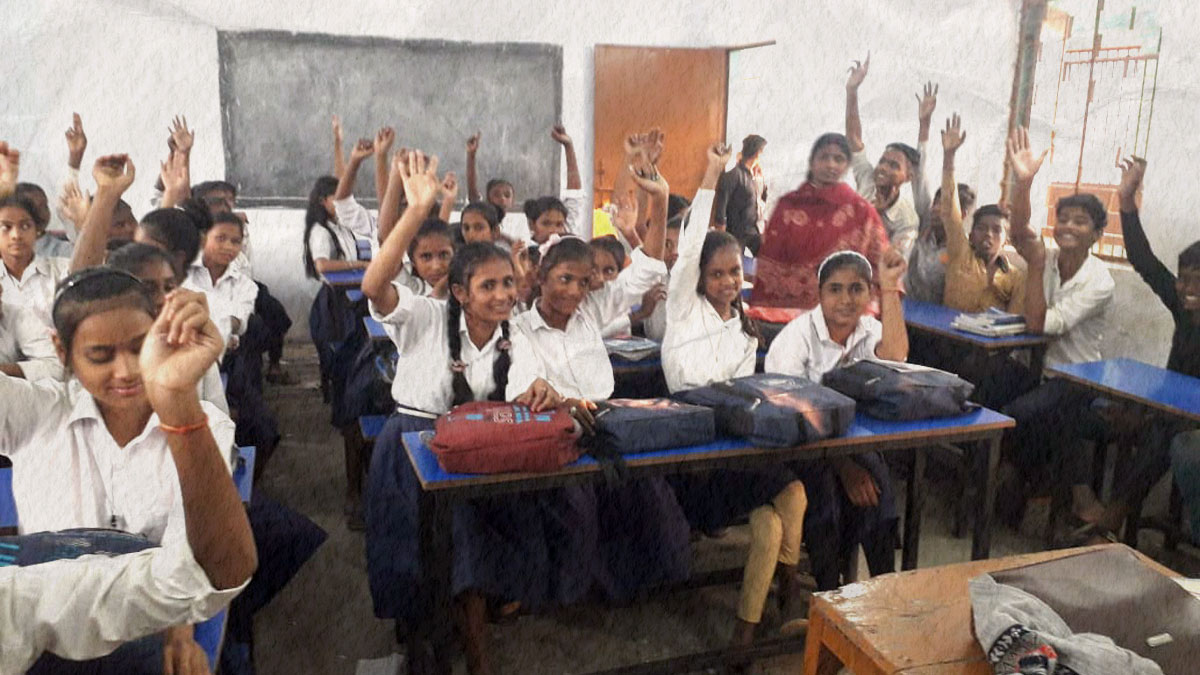
Educate, Don’t Marry: Shiksha Chaupal Campaign in Bihar Sparks Hope for Young Girls
Nidhi Kumari and her two siblings live in Ghosrama village in Bihar. She studies in class 9, while her sister is in class 7 and her brother is in class 3. Nidhi speaks to us from her home, over a video call, with her mother Chunchun Devi by her side. “We were thinking of getting her married after class 7 or 8, just like I was married off after class 7,” said Chunchun Devi. “We have three children and old in-laws, how do we account for her school expenses?”
Child marriage is common in the village. Nidhi tells us about her friend Madhu, from her previous class, who was married off in 2024. “She wanted to study and we even helped her with extra classes to help her cope with academics, but her guardian wanted to get her married off. She was one of five sisters. We even tried to convince her mother, to let her study till class 10, maybe she could try for some or the other job if she had that qualification. Her guardian scolded me for being a small child, for trying to convince her against her wishes,” said Nidhi.
Shortly after this incident, in October 2024, Nidhi and her mother were roped in for a campaign called ‘Shiksha Chaupal’ under Shikshagraha, where they both took an oath to continue their studies till at least Class 12. Nidhi and her mother were among 68,000 others who took the oath.-1734945534346.jpg)
Nidhi added, “If this oath-taking happened just a few days ago, Madhu could be saved from child marriage.”
Like Nidhi, two others we spoke to, were also slated to be married off had the families not taken the oath to complete the girls’ education till at least Class 12. Held in seven districts in Bihar, the campaign saw widespread participation from all members of society.
1
2
3
4
"I was the first girl from my village to step into a college, and that changed everything—for me and for the young girls in my village who saw that it was possible,” said Mrs. Kumari Shibulal, Chairperson, Shibulal Family Philanthropic Initiatives, which is supporting the Shikshagraha movement. “Quality education is a doorway to entirely different life trajectories, especially for girls. That’s why I deeply support Shikshāgraha's focus on gender equity."
HerZindagi spoke to more families who took the oath and stakeholders behind the campaign to understand its purpose and effects better.-1734945552708.jpg)
Child Marriage Rates in India Have Declined, But Not Enough
According to a UNICEF report from 2023, despite declining child marriage rates, the country still accounts for one in three of the world’s child brides.
Statistically, over 23% or one in four young women in India married before turning 18.
Some states had a higher prevalence of child marriage than others. The report stated that over half of the girls and women in India who married in childhood lived in five states: Uttar Pradesh, Bihar, West Bengal, Maharashtra, and Madhya Pradesh.
Read: Belief and Betrayal: Exploring the Complex Relationship Between Women and Godmen in India
The report added that child marriage has lifelong consequences for girls and their families, with reverberations that span generations. Child brides often give birth as adolescents and rarely continue their education after marriage.
One example stated includes child brides being more likely to report wife-beating to be justified, and even experience such violence themselves. Ending child marriage by 2030 is one of the Sustainable Development Goals set by the United Nations in 2015.
One of the key ways of tackling the problem of child marriage, and finding a way to give young women agency was through ensuring their access and commitment to education.
Shiksha Chaupal: A Campaign to Continue Girls’ Education
Shikshagraha is the people's movement for education equity. As participants in Shikshagraha, half a dozen women's federations of Bihar in partnership with Mantra4Change and ShikshaLokam organised Shiksha Chaupal in seven districts of Bihar. They initiated this campaign during Navratri, a festival where a Goddess is worshipped over nine days.
They centred the campaign around questioning why a society which worships Goddesses, doesn’t offer their women the right to education and equality. Navratri being a time when families step out and gather in different places, helped get people together organically.
Urmila, who has worked towards encouraging the education of teenage women in Bihar since the beginning, said, "I am sure if opportunities are provided, every daughter can fight for her rights, complete her education and join the mainstream of society."
A core tenet of the campaign is working with communities — rather than around them — to co-
opt all stakeholders into the journey toward gender equity and ensure sustainability. Male
members, village elders, panchayat members, teachers and local government leaders were actively engaged in shaping and supporting this transformation.-1734945639130.jpg)
Lucky Kumari, a member involved with spreading awareness said, “We got married at an early age, and we suffered for it. We don’t want more girls to go through what we went through.”
People present pledged by extending their hands or by placing their hands on the burning diya that they would educate their daughters at least till 12th standard.
Rangolis, slogans and signings on the cloth were also part of the event in many places.
Why Shiksha Chaupal Was Initiated in Bihar
Bihar was chosen as the first state to begin the Shiksha Chaupal campaign, as it is one of India’s most socio-economically disadvantaged states. It also ranks lowest in the country on SDG 4 - Quality Education indicators.
Bihar has the highest rate of child marriage in India, with 40% of girls marrying before the legal age of 18 (NFHS-5, 2022). At 11%, nearly double the national average of 6.8%, teenage
pregnancies significantly impact girls’ ability to continue schooling. The secondary school dropout rate for girls is 21.4%, higher than for boys.
Also read: Unveiling the Disproportionate Impact: Women in the Shadow of Disasters
Barriers to Education for Girls
All three of the families we spoke to, highlighted poverty as the main reason for them discontinuing their daughter’s education.
Chunchun Devi highlighted that her husband works as a labourer, and she works in the fields to make ends meet. Affording education and other related costs is always a concern for three children. “My daughter went to school without eating for ten days, as I couldn’t get her food ready. She refuses to miss school. The school is over 2 km away, and there’s no transport, so she cried for 15 days for a bicycle. After that, her father agreed to buy her a bicycle. We bought a second-hand bicycle for INR 3000. Now she goes to school on that.”
Nidhi is determined to complete her studies and says she’ll seek help from members part of the campaign if needed. A school-loving girl, her favourite subject is science. She aspires to become a police officer someday.
Patriarchy plays its part too, in urging women to drop out of schools. Neighbours often question Chunchun Devi about educating the girls, telling her that if Nidhi dropped out, she could help her mother at work or home instead.
In another family, the mother Savita Devi said she’s finding it hard to continue her daughter’s education, but another relative is funding her son’s education. Her son is in Class 10 and lives in a hostel, and her daughter Anushka Kumari is in class 9. She said, “An uncle is funding my sons’s schooling, but they aren’t willing to help out with more of our children.” Anushka’s marriage was fixed with a boy but has been called off after the mother-daughter duo took the oath as part of Shiksha Chaupal.
Social factors such as the perception that younger girls require smaller dowries and the stigma against highly educated brides further contribute to parents wanting to marry their daughters off, instead of completing their education.
The Way Forward
The way forward for Shikshagraha entails addressing the root socio-cultural issues and working more deeply with the community to ensure girls access education. Shiksha Chaupals will become a key vehicle for this.
"As we look ahead, addressing the intersection of poverty and gender inequality remains at the heart of our mission,” explained Anubhuti Srivastava, Program manager at Shiksha Lokam. “We know that empowering women and girls is crucial to breaking the cycle of poverty and building stronger communities.”
These initiatives are aimed to eventually empower women, and uplift their lives.
She said, “By prioritising gender equity in education, and leadership opportunities, we are creating pathways for young women to rise above the barriers of poverty, enabling them to contribute meaningfully to their communities and society at large. Our vision is to ensure that every girl, regardless of where she is born, has the tools and support she needs to thrive and build a brighter future."
The movement, however, needs to be a community-driven initiative, where all stakeholders are aligned in mission.-1734945682458.jpg)
Khushboo Awasthi, Co-Founder, Mantra4Change and Shikshagraha said, "To make education accessible, high-quality and meaningful for our children, many such deep-seated beliefs and practices need to be challenged and changed. Hence we are designing Shikshagraha as a movement. A movement thrives when there is aligned action among the government, NGOs, and communities. When communities take ownership of identifying their socio-cultural challenges and solving them locally, as we witnessed in the Shiksha Chaupals, sustainable change happens. When governments and NGOs co-create such spaces and deeply listen to these challenges, they can design programs that are far more impactful. Together, these efforts have the potential to catalyse exponential change and make the dream of education equity for our country possible. At Shikshāgraha, we are deeply committed to fostering multi-actor partnerships across India."
1
2
3
4